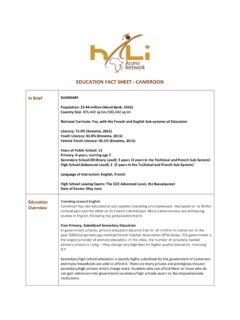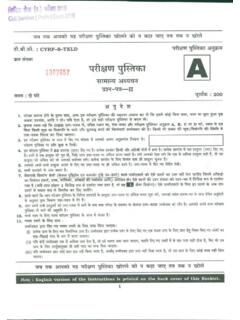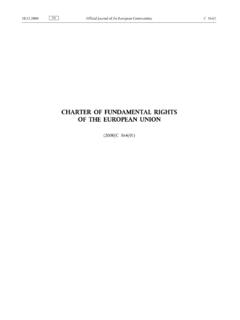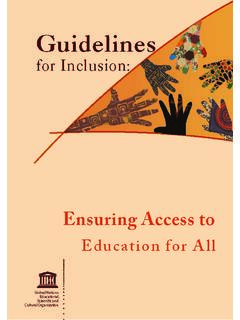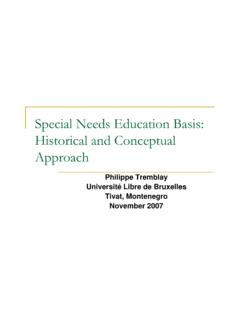Transcription of Tanzania - Education Fact Sheet - HALI Access Network
1 Education FACT Sheet - Tanzania In Brief SUMMARY Tanzania Population: million Tanzania Size: 943,303 sq. km/364,211 sq. mi National Curriculum: Yes Literacy: Youth Literacy: Female Youth Literacy: Years of Public School: 13 Primary: 7 Secondary Ordinary Level: 4 Secondary Advanced Level: 2 Language of Instruction: Primary School - Kiswahili, Secondary School - English High School Leaving Exams: Yes Date of Exams: May Education Overview free Primary and Secondary O-Level Education Primary Education is a right for all children in Tanzania and so it is fee- free , and compulsory . The government is the largest provider of primary Education , accounting for 97% of enrolment in 2012. The free primary and secondary Ordinary Level Education in schools was mandated in the Education and Training Policy issued in 2014, and the government started implementing the policy in November, 2015. However, while most fees including exam fees are covered, some indirect costs still remain such as uniforms and stationery costs.
2 Private pre-school is also available. The percentage of students advancing to O-Levels has dropped dramatically since 2000 while the number of students attending universities has increased more than five-fold during that period. Tanzania s Education Expenditure: of GDP (World Bank, 2015) Pupil/Pupil Ratio: 57:1 Entering primary school having attended pre-school: (EFA, 2013) Completing primary school: 74% (public primary Education is free apart from uniforms, stationery, etc.) Transition to secondary Ordinary Level studies: in 2014 (UNESCO, 2016) Completion of secondary Ordinary Level studies: 50% in 2012 Transition to secondary Advanced Level studies: 11% in 2012 (decreased steadily from 28% in 2000) Completion of Advanced Level secondary studies: 28% Achieving passing grades on A Level exams: 93 % Number taking leaving exams: 385,767 (2017) Universities: 26 Other institutions of higher learning: 16 Number of university students: 52,831 (2016) (an increase from 9,220 in 2000) School System Progression not Automatic Tanzanian Education can be described as follows: 2 years optional pre-school from age 5 or 6 (100% private provision) 7 years in basic primary Education (for children aged 7-13) 4 years of lower secondary Ordinary Level Education (ages 14-17) 2 years of secondary Advanced Level Education (ages 18-20) NB.
3 The basic primary level classes are known as Standards, while the secondary ones are known as Forms. Progression from one level to another in public schools is not automatic as it depends on national examination results, overseen by the government at the end of Standard 7, Form 4 and Form 6, through the National Examinations Council of Tanzania (NECTA). In fact, the Standard 7 exam allows the rationing of the limited space available by pushing out children who do not achieve the required marks. Although it is possible to retake a year, many children from poor families lose the incentive to continue and do not do so. Grading systems: The grading system in Tanzania for the Form 4 and Form 6 final results is based on exam letter grades, grading scales (points and divisions) and schools continuous assessment. a. Letter Grades/points awarded (i) Form 6 Grade Marks Points Remark A 80-100 1 Excellent B 70-79 2 Very Good C 60-69 3 Good D 50-59 4 Average E 40-49 5 Satisfactory S 35-39 6 Satisfactory F 0-34 7 Fail (ii) Form 4 Grade Marks Points Remark A 75-100 1 Excellent B 65-74 2 Very Good C 45-64 3 Good D 30-44 4 Satisfactory F 0-29 5 Fail b.
4 Cumulative Grade Scale Students are ranked into different Divisions based on the total number of points for the seven highest scores for Form 4 and for the three principle subjects for Form 6. The distribution of the cumulative points into the different Divisions is as follows: Division Form 4 total points Form 6 total points Remark I 7-17 3-9 Excellent II 18-21 10-12 Very Good III 22-25 13-17 Good IV 26-33 18-19 Satisfactory 0 34-35 20-21 Fail In addition to the examinations taken at the end of Forms 4 and 6, continuous assessment tests given at school account for 30% of the awarded marks for each subject. SECONDARY SCHOOLS Primary School Leaving Examination marks the end of the primary Education cycle and is used as the basis upon which pupils can join the secondary Education cycle. At the secondary level, there are basically four kinds of schools available. 1. Government schools: This is the largest group. Most of them are day schools, where students have to commute to school and back home, although a few others offer hostels for boarding.
5 There are no tuition fees from Form 1 to Form 4. In high school (Forms 5 and 6), there is a minimal tuition fee of just about $ for day scholars and about $ for boarding students. Due to low tuition fees, government-owned schools are the major providers of secondary Education in Tanzania . However, due to low running costs, government-owned schools employ unqualified teachers and school services are usually poor. 2. Government special schools : In addition to the local public schools in every ward, the Tanzanian government has established 8 special schools . These schools select the students who performed highly in their primary school leaving exams to join their Ordinary Level program, and the best students in Form 4 to join their Advanced Level (Form 5 and 6) program. 3. Privately owned NECTA schools: These are owned by individuals, missionary groups or private organizations. Most are boarding schools, while others provide both boarding and day options.
6 These tend to be better in quality compared to public 4. schools and have mid-fee ranges, mostly $500 to $ per annum. They tend to attract Tanzanian middle class families and almost always beat the local and special government schools in final exam results. 5. International private schools: These are the boarding and day schools that offer the best quality of Education in Tanzania . They offer international curricula such as International Baccalaureate and Cambridge International. These schools tend to attract wealthy Tanzanians, although a few scholarships are available to students from low-income families. Higher Education POST O-LEVELS Higher Education and training encompass post-Ordinary Level secondary Education in Tanzania , leading to the award of certificates, diplomas and degrees. Even students who do not do Advanced Level studies can thus pursue higher Education . The Tanzania Commission for Universities (TCU) monitors the provision of Education in all universities in the country.
7 The vision of this commission is to maintain a system that provides higher Education capable of supporting national social, economic and cultural development in a global context. University Education in Tanzania takes about three years for liberal arts and business courses, four years for science engineering courses, and five years for medicine. The Tanzanian higher Education system is made up of public and private universities, university colleges, and vocational/technical training institutes. All public higher Education institutions in the country are semi-autonomous and subsidised by the government. The country has a total of 26 universities (10 public and 16 private), and 15 university colleges (4 public and 11 private), all of which are regulated by the TCU. The country also has the Open University of Tanzania , which was established for distance Education in 1995. Approximately 1% of Tanzanian citizens of relevant age are enrolled in higher Education after meeting all academic requirements.
8 The female to male ratio for gross enrolment in tertiary Education is :1. Literacy among people aged 15-24 is 77%. Issues with the Education System UNDER-RESOURCED SCHOOLS Most government schools in Tanzania have poor study environments, making it hard for students to learn. The issues include a lack of resources and facilities like books in school libraries and laboratories for schools offering science subjects. Many schools, especially those in the rural areas, do not even have enough classrooms and desks. This makes most schools operate on the shift system, meaning that some students go in the morning and some in the afternoon. Because poverty is a common feature in rural Tanzania , reflected in poorer Access to and lower quality of Education , educational outcomes in urban areas are consistently higher than those of rural areas. Teaching methods are often gender-biased, resulting in most boy students performing better than girls. The teaching is not meant to develop critical thinking skills, but emphasizes students cramming what is taught so as to repeat it on national the examinations.
9 A national survey of violence against children revealed that many teachers exceed the legal limits of officially sanctioned corporal punishment. Over 50 percent of girls and boys interviewed reported being punched, kicked or whipped by a teacher. Rapid expansion in enrollment has meant that classroom sizes have increased with an average of 66 pupils in each government primary school classroom in 2011. Mwanza Region is hardest hit, with an average 89 pupils per classroom. In some classrooms there can be as many as 200 children , particularly at the lower primary school grade levels. Most schools face extreme shortages in textbooks, desks, chairs, toilets, water supply, and hand-washing facilities. On average there is one textbook for every 5 students and 1 latrine for 54 and 51 boys and girls respectively. This is far below the normal pupil/latrine ratio of 25:1 for boys and 20:1 for girls, and impacts especially on girls attendance and performance. In Tanzania , a very large number of girls become pregnant and drop out of school every year, and current government policy does not allow for their re-admission.
10 In 2010, over 7,000 girls dropped out of primary and secondary schools due to pregnancy. The Tanzanian government funds teacher training programmes, but despite this most government schools do not have enough teachers, and even the ones there are generally not as well educated as they should be. In addition, teachers living conditions are poor and salaries are very low, making them dispirited. Academic Calendar The academic year for public and private primary and lower secondary schools runs from January to December, with four terms. Advanced Level Form 5 and 6 students begin their year in June and end in May. The academic year for most International schools (International Baccalaureate diploma and Cambridge schools) runs from August to June, followed by a two months summer holiday. After high school, students join private and government universities and colleges that often admit students in late October. The academic year for universities runs from late October to September the following year.
